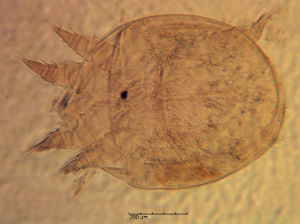Worms and mites unearth clues in Swiss homicide case
08 January 2018

Microscopic clues provided by worms and mites have led to a major forensic science discovery in an active Swiss homicide case published today in the journal Scientific Reports.
Using an original dating protocol, an international group of researchers including a forensic scientist from the University of Reading and led by UniNE biologists has been able to identify the victim after human remains were found in a Swiss forest.
Using the results from a number of tests alongside evidence available, the team concluded that the remains were from a person who died more than a year before being discovered – and was stored in a confined environment before being left in the forest where it was found.
Dr Alejandra Perotti, Associate Professor in Invertebrate Biology at the University of Reading who worked on the research said:
“By looking at a variety of worms, mites and microorganisms found on the body and the surrounding soil, we were able to unravel information related to the crime scene and the victim, using a novel combination of methods of analysis, which have not been used in human forensics as far as we’re aware.”
The paper which documents the discovery, has been published after the Institute of Forensic Sciences in Bern, Switzerland called on the University of Neuchâtel (UniNE) and an international team to analyse soil in the vicinity of human remains found in a Swiss forest.
By combining various information from carbon-14 analysis of bone and hair, soil chemistry, and organisms found beneath the cadaver (mites, nematodes, and micro-eukaryotes), specialists have been able to determine that the remains of the deceased had already been at the place of his discovery for more than a year. The analysis of the bones identified the victim, a young man who was seen alive 22 months before the discovery of these human remains.
Professor Edward Mitchell, Director of the Soil Biodiversity Laboratory at UniNE said:
"The fact that several methods have given consistent results on the age of the corpse reinforces our conclusions. In particular, the analysis of mites reveals that the corpse was initially stored in a confined environment.”
Enrique Lara, a former researcher at the University of Neuchâtel who currently works at Real Jardín Botánico in Madrid said: "New technological developments have revolutionized our perception of microbial diversity, which far exceeds that of animals and plants.
"These methods can be applied in the forensic sciences to establish new bioindicators, that is, microbial controls that are associated with different stages of cadaver decomposition and thus can provide information about the date of death."
This is the first time that analyzes of roundworms (nematodes) and the diversity of micro-eukaryotes (fungi and other non-grouped organisms called protists) in the soil have been applied in an investigation of an alleged homicide.
Mitchell said:
"We developed these methods by studying the decomposition of carcasses of pigs in the forest. We thus gathered complementary knowledge on nematodes, micro-eukaryotes and soil chemistry that allowed us to establish a diagnosis. Since 2009, more than 800 samples corresponding to different stages of decomposition have been analyzed to establish post-mortem interval evaluation methods.”
Two Swiss laboratories, the UniNE Soil Biodiversity Laboratory and the Forensic Science Institute of the University of Bern, the Laboratory of Acarology at the University of Reading (Great Britain), as well as Real Jardín Botánico de Madrid (Spain), have gathered their efforts to try, using various methods of analysis, to reconstruct the case.
Full citation:
Szelecz, I, Lösch, S, Seppey, CVW, Lara, E, Singer, D, Sorge, F, Tschui, J, Perotti MA, Mitchell EAD, 2018: Comparative analysis of bones, mites, soil chemistry, nematodes and soil microeukaryotes from a suspected homicide to estimate the post-mortem interval. Scientific Reports, 8 January 2018, doi: 10.1038/s41598-017-18179-z.
